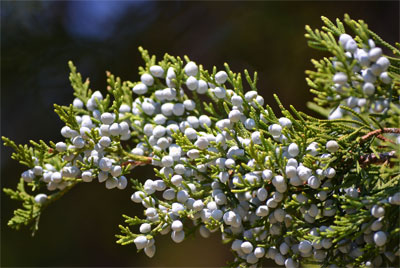Texas Tree Tips: March 2014
by Steve Houser
Tree Species Profiles —
Top-Rated Shade Trees
Eastern redcedar, Juniperus virginiana
The Eastern redcedar, Juniperus virginiana, is in the Cypress or Cupressaceae family and is a tree well worth consideration for your landscape. To the novice wondering why there is always weird foreign lingo after each plant or tree name, the Latin moniker identifies the exact species to be recognized, rather than being confused with others that may have similar common names. (I swear it is not listed to build the egos of people in the green industry — for the most part.) The species is also known as Eastern juniper, red juniper, Southern redcedar, pencil cedar, and Carolina cedar.

Mature Eastern redcedars break out of their pyramidal shape and grow to 70 feet in height. All photos by Bill Seaman.
Eastern redcedar is native to Eastern and North Central Texas, but its range appears to have been expanding over time. In the western edges of its range, it often intermixes with Ashe juniper, Juniperus ashei. The primary difference between the two is in the growth form. Ashe juniper is shorter in height (up to 30 feet tall) and typically includes multiple stems. The Eastern redcedar is more likely to be a single-trunked tree that can grow to 70 feet or more in height, with a crown spread of 50 to 60 feet or more. There are also a number of Eastern redcedar cultivars that have been selected by nurserymen because of their unique sizes, colors, and shapes.
The growth form of Eastern redcedar is typically a pyramid or Christmas tree form, with a pointed top when it is young that often reverts to a more flat-topped crown as it ages. Redcedars can tolerate dryer sandy soils or clay, but they do not like “wet feet,” or roots. These evergreen conifers have a moderate-to-fast growth rate while young, and a moderate-to-slow rate as they age. Their life expectancy can be as long as 300 to 400 years.

Drought tolerance and dense evergreen foliage that grows to the ground are characteristics that make Eastern redcedar highly desirable in many Texas landscapes.
Eastern redcedars are great trees to screen an unwanted view. They are moderately drought tolerant, and they are a superior tree choice over their disease-prone lookalike, Leyland cypress. Their scaly needles and reddish-brown-to-gray bark offer a unique texture to any landscape. The species has no significant insect or disease problems. It is a host plant for cedar-apple rust, but the disease does not cause a major health problem for the species.

Underneath a thin layer of fibrous bark, Eastern redcedar has a fragrant wood that is highly resistant to decay.
The wood of Eastern redcedar is very fragrant, and the heartwood is red with white sapwood. The wood is also known to repel insects and is used to line closets and drawers to keep insects out. Because of its resistance to decay, the wood is used for fence posts and other exterior projects. In a recent nature walk, a participant asked me if deer would browse or eat parts of an Eastern redcedar. Since I was not sure of the answer, I noted that given the aromatic qualities of the wood, they might choose to eat it when they have bad breath.
It is one of the first trees to reestablish itself after the soil is disturbed or if there is a fire. The trees are also known to grow quickly in an open area that is not maintained by mowing, tilling, or other practices.

The blue-grey berries produced by Eastern redcedar add interest to the landscape and provide wildlife with an abundance of food.
The blue fruit is a favorite of wildlife. It appears to be a berry, but it is actually considered a type of cone. If you ever want to know what local trees and plants that birds favor, look along any fence row that is not maintained. After birds eat various types of seed such as that of Eastern redcedar, they often perch on the wire and effectively spread the seeds of their favorite trees and plants. Of course, birds leave you the most wonderful gift of new seeds for your flowerbeds as well.

